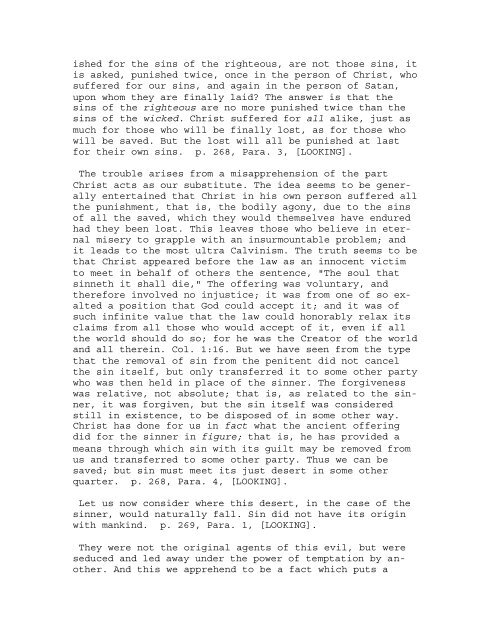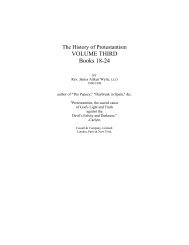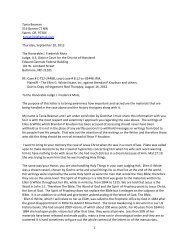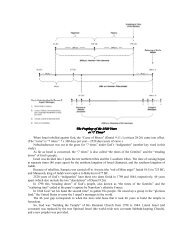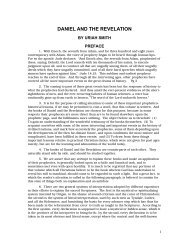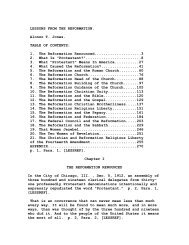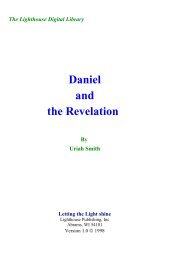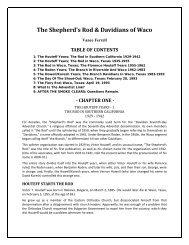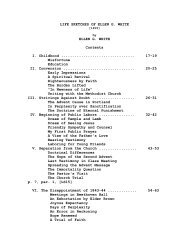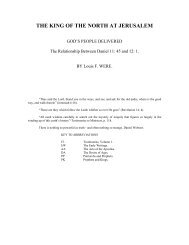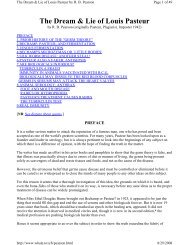LOOKING UNTO JESUS OR CHRIST IN TYPE AND ANTITYPE. BY ...
LOOKING UNTO JESUS OR CHRIST IN TYPE AND ANTITYPE. BY ...
LOOKING UNTO JESUS OR CHRIST IN TYPE AND ANTITYPE. BY ...
Create successful ePaper yourself
Turn your PDF publications into a flip-book with our unique Google optimized e-Paper software.
ished for the sins of the righteous, are not those sins, it<br />
is asked, punished twice, once in the person of Christ, who<br />
suffered for our sins, and again in the person of Satan,<br />
upon whom they are finally laid? The answer is that the<br />
sins of the righteous are no more punished twice than the<br />
sins of the wicked. Christ suffered for all alike, just as<br />
much for those who will be finally lost, as for those who<br />
will be saved. But the lost will all be punished at last<br />
for their own sins. p. 268, Para. 3, [<strong>LOOK<strong>IN</strong>G</strong>].<br />
The trouble arises from a misapprehension of the part<br />
Christ acts as our substitute. The idea seems to be generally<br />
entertained that Christ in his own person suffered all<br />
the punishment, that is, the bodily agony, due to the sins<br />
of all the saved, which they would themselves have endured<br />
had they been lost. This leaves those who believe in eternal<br />
misery to grapple with an insurmountable problem; and<br />
it leads to the most ultra Calvinism. The truth seems to be<br />
that Christ appeared before the law as an innocent victim<br />
to meet in behalf of others the sentence, "The soul that<br />
sinneth it shall die," The offering was voluntary, and<br />
therefore involved no injustice; it was from one of so exalted<br />
a position that God could accept it; and it was of<br />
such infinite value that the law could honorably relax its<br />
claims from all those who would accept of it, even if all<br />
the world should do so; for he was the Creator of the world<br />
and all therein. Col. 1:16. But we have seen from the type<br />
that the removal of sin from the penitent did not cancel<br />
the sin itself, but only transferred it to some other party<br />
who was then held in place of the sinner. The forgiveness<br />
was relative, not absolute; that is, as related to the sinner,<br />
it was forgiven, but the sin itself was considered<br />
still in existence, to be disposed of in some other way.<br />
Christ has done for us in fact what the ancient offering<br />
did for the sinner in figure; that is, he has provided a<br />
means through which sin with its guilt may be removed from<br />
us and transferred to some other party. Thus we can be<br />
saved; but sin must meet its just desert in some other<br />
quarter. p. 268, Para. 4, [<strong>LOOK<strong>IN</strong>G</strong>].<br />
Let us now consider where this desert, in the case of the<br />
sinner, would naturally fall. Sin did not have its origin<br />
with mankind. p. 269, Para. 1, [<strong>LOOK<strong>IN</strong>G</strong>].<br />
They were not the original agents of this evil, but were<br />
seduced and led away under the power of temptation by another.<br />
And this we apprehend to be a fact which puts a


